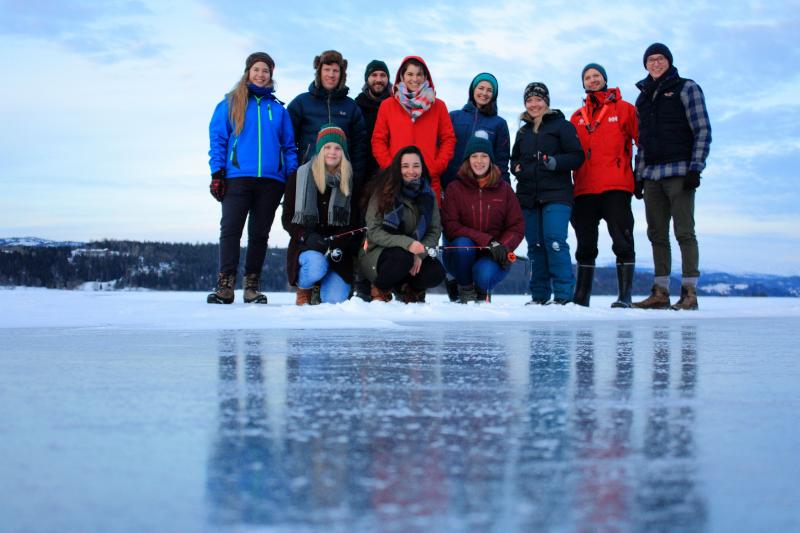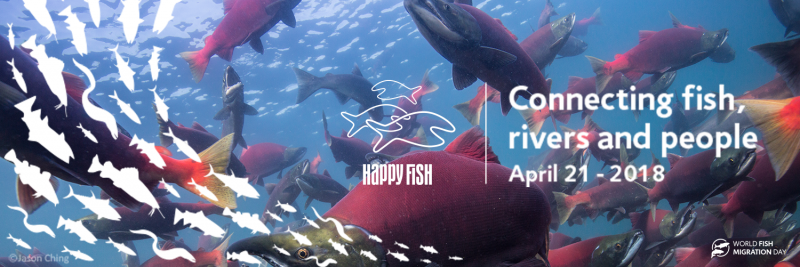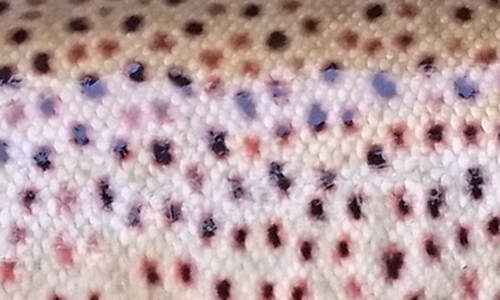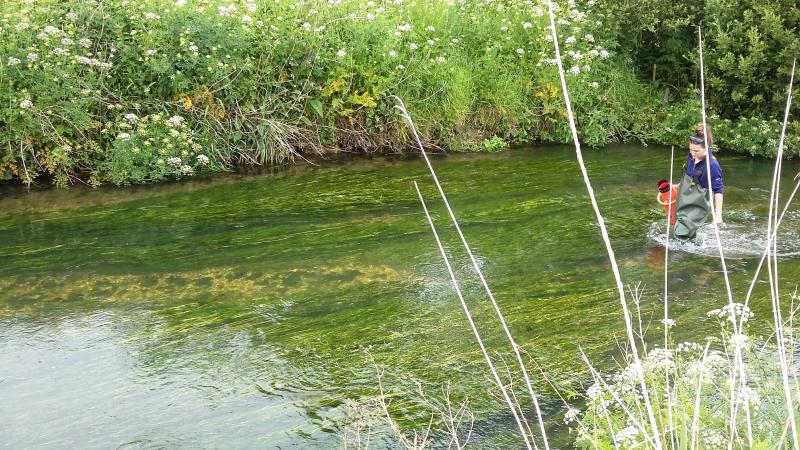A photo of one small patch of river bed on a headwater stream of the River Test encapsulates why the sorting of river bed material is so important.
Why is sediment sorting important?
Posted on October 25, 2018

Posted on October 25, 2018

A photo of one small patch of river bed on a headwater stream of the River Test encapsulates why the sorting of river bed material is so important.
Posted on October 03, 2018

A WTT advisory visit in 2016 on behalf of Birdsgrove Fly Fishing Club (BFFC) to the River Dove, Derbyshire, identified seven weirs along the 5km length of river fished by the club. The impoundment of water by these structures is detrimental to river habitat, fly and fish populations,especially from a fish passage persepctive, and natural sediment transport. The advisory visit report stimulated a debate within the club about what could be done to improve the fishery and it was decided to work towards the removal of the two weirs that had been built by the club in the past.
Posted on September 07, 2018

I’ve been looking forward to this moment for quite some time now…..well, at least a year. The monitoring of my pet project from pre-intervention (weir notching and removal / partial demolition over six structures) to several years post is quite revealing, and I’ll let the data do the talking.
Now, as a scientist, I know there are a few caveats associated with the figure above. But as there was no specific funding pot for the monitoring of the works for this duration, I am making the best of the situation. So, all surveys were carried out in each of the years for roughly the same amount of time (effort), over similar distances, using similar kit, and roughly the same time of year (although 2018 was a little later because of the incredibly dry spring / summer we have just experienced). Ideally, all of these parameters would have been standardised; ie identical each time.
Posted on September 03, 2018
What has happened to our young trout during all the recent 'abnormal' weather? It's a question I have heard discussed and been asked directly quite regularly of late, and I intend to post a response with a relatively local flavour, here on the blog, in the not too distant future. However, to pre empt that, I thought I would post some thoughts from my colleague in the south, Andy Thomas. Glaciers were still retreating from Cumbria when Andy first started working on rivers, so he's seen a thing or two....
Please note that this article was originally published in the WTT Summer Newsletter (one of the perks of being a member), and hence was written prior to the extended warm & dry period that subsequently ensued!
Posted on July 09, 2018
And so it comes to pass….Coniston Cold weir, which in various forms has been a man-made obstruction to fish passage on the R Aire in N Yorkshire for the past 180 years at least, is no more. Instead, there is now 20.4km of uninterrupted free passage along the Aire and a major tributary.... and all for less than £8k!
Coniston Cold Weir: 19m wide and 1.2m headloss, with a 4m horizontal block-stone apron
I will not reinvent the wheel and spend time here discussing how weirs cause environmental issues. The evidence is abundant and simple to find in the scientific literature, and my colleague Paul Gaskell has recently summarised much of that, here. Then there are global-local events like World Fish Migration Day to raise awareness and I would wager that almost every conservation body involved with river restoration has a hit-list of target weirs on their local patch.
Posted on June 14, 2018

Hopefully a few sea trout have found a bit of water (not round here mind) and are starting to return to our rivers at the moment. Fitting then to hand over the blog to Angus Lothian, a PhD student at Durham University (see his first blog here) to reflect on a new network for sea trout research.
Salmo trutta is a truly fascinating ‘species’, with such varying life history strategies and showing large phenotypic plasticity, exemplified by their key characteristic of partial-migration. It is not yet fully known what drives partial-migration, with a component of a population of trout smolting and emigrating from rivers to sea, and the rest remaining river-resident. Although the trout has often played second fiddle to Atlantic salmon, recent surges in the interest of trout ecology and biology, and in particular sea trout, has led to a rise in the number of scientists and PhD students researching this field.
Posted on May 23, 2018

I’ve just had the pleasure of hosting two MSc students from Queen Mary University of London (co-supervised with Dr Chris Eizaguirre), partly for the WTT Annual Get Together, and partly to undertake some fieldwork specifically for Charlotte Pike’s project. I alluded to their research projects in a former post and now I have the pleasure of handing over to them to update you.
Charlotte’s project focuses on the use of stable isotopes to determine the success of river restoration. I will be analysing samples from pre and post intervention works against an unimpacted control site on the same river to see how the restoration has affected the ‘architecture’ of the food web. Hopefully it should be more like the control! The intervention works have been carried out by the Ribble Rivers Trust at two locations; Bashall Brook and Towneley Hall. At Bashall Brook, a riparian zone has been created where banks of the river were previously bare; essentially livestock exclusion fencing now removes the impacts of grazing and poaching. This strip of vegetation acts as a buffer to reduce nutrient run-off from farmland, keeps the ground more stable and resilient to flood damage to reduce soil erosion, and provides necessary refuge for wildlife. At Towneley Hall, a partial weir removal and a rock pass re-instates the connectivity of the River Calder allowing fish to move between formerly fragmented habitats. These interventions have been conducted to improve the quality of the habitat at these two sites, and it’s my job to find out what changes have occurred as a result!
Posted on March 29, 2018

World Fish Migration Day is a biennial event and this year falls upon the 21st April. If you have not heard of it, it’s a global-local event to create awareness of the importance of open rivers and migratory fish. Check out some of the events that are going on around the world - there may be something near to you:
Posted on March 27, 2018
Quite a few of our guest bloggers recently have been at the same conference. Unfortunately, I could only follow the key scientific revelations via Twitter from afar but I have been alerted to some work of which I was previously unaware, so I am hoping to establish contact with those people and perhaps they will contribute a blog or two in the near future. Here, Jess Marsh (she of the water crowfoot and salmonid community research) has kindly offered to tell us briefly about NoWPas.
A week after the 14th annual NoWPaS workshop was wrapped up in spectacular style with a traditional Finnish nuotio, or campfire, we are reflecting on an inspiring week of exciting salmonid research, new experiences and friendships.
NoWPaS 2018 participants at Oulanka Research Station, Finland. Photo taken by Angus Lothian
Posted on March 10, 2018

Gather some fine fishy folk into a room and get them talking (as if you could stop ‘em) about brown trout. How long do you reckon it would be before the topic of colour or more likely spotting pattern would creep in? Let’s face it, we love our spotties! It’s just such an integral part of their beauty and wonderful diversity.
So, for no other reason than the sheer beauty of ‘em, I’m going to ask you good supporters of WTT to snap a few images of wild brown trout spots when you’re out this season but specifically trying to focus on one area – square on and below the dorsal fin. In fact, just like the images scattered around this page, trying to avoid any large patches of glare / reflection / contrast. These images were lifted from 'whole' fish shots, and hence aren't the best quality. I'm hoping you can provide some close ups of the fish flank.
Posted on February 22, 2018
The observant amongst you may have noticed and even (hopefully) read the blog I posted from MSc students at Queen Mary University of London after they had completed an electrofishing survey with me as part of a training exercise. Each year, at the same time, a cohort of Freshwater & Marine Ecology students ‘(re)samples’ Woodplumpton Brook where I have been working with Wyre RT to improve the watercourse habitat and connectivity. Well, two of the most recent students were so enthused by the experience and some of the work that I do at the WTT that they have signed up to complete their MSc projects under my supervision and with Dr Chris Eizaguirre (QMUL).
Both of the projects I will outline below have actually been in existence for a while, and both use my academic expertise in stable isotopes. Stay with me! Each is in partnership with other organisations, and so the students will benefit from work experience outside of the purely academic arena, as well as from developing an extended network of contacts which may well be useful further down the line at job-hunting time!
Posted on February 02, 2018
Posted on January 24, 2018
Posted on January 23, 2018
Posted on January 22, 2018

There are few more captivating sights than a river reach swathed in water crowfoot flowers, for what delights might be hidden beneath? William Barnes (1801–1886) was certainly inspired:
O small-feac’d flow’r that now dost bloom,To stud wi’ white the shallow Frome,An’ leäve the clote to spread his flow’rOn darksome pools o’ stwoneless Stour,When sof’ly-rizèn airs do coolThe water in the sheenèn pool,Thy beds o’ snow white buds do gleamSo feäir upon the sky-blue stream,As whitest clouds, a-hangèn highAvore the blueness of the sky
This humble member of the buttercup family is considered by ecologists as an autogenic engineer: it can change the surrounding environment via its own physical structure. While many people have tried to study where and why water crowfoot grows, especially in relation to nutrients, few have considered how the plant influences the assemblages of organisms around it. Cue Jessica Marsh’s PhD study….